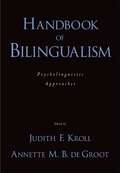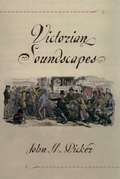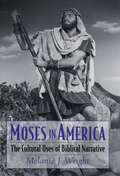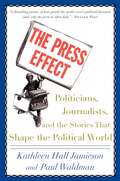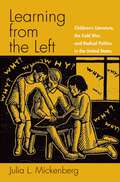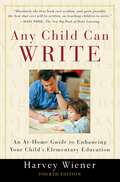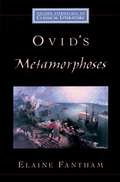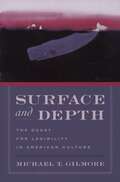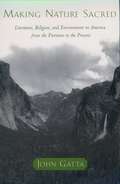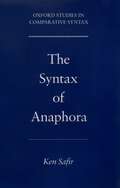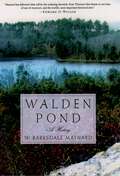- Table View
- List View
Handbook of Bilingualism: Psycholinguistic Approaches
by Judith F. Kroll Annette M. B. De GrootHow is language acquired when infants are exposed to multiple language input from birth and when adults are required to learn a second language after early childhood? How do adult bilinguals comprehend and produce words and sentences when their two languages are potentially always active and in competition with one another? What are the neural mechanisms that underlie proficient bilingualism? What are the general consequences of bilingualism for cognition and for language and thought? This handbook will be essential reading for cognitive psychologists, linguists, applied linguists, and educators who wish to better understand the cognitive basis of bilingualism and the logic of experimental and formal approaches to language science.
Victorian Soundscapes
by John M. PickerFar from the hushed restraint we associate with the Victorians, their world pulsated with sound. This book shows how, in more ways than one, Victorians were hearing things. The representations close listeners left of their soundscapes offered new meanings for silence, music, noise, voice, and echo that constitute an important part of the Victorian legacy to us today. In chronicling the shift from Romantic to modern configurations of sound and voice, Picker draws upon literary and scientific works to recapture the sense of aural discovery figures such as Babbage, Helmholtz, Freud, Bell, and Edison shared with the likes of Dickens, George Eliot, Tennyson, Stoker, and Conrad.
Victorian Soundscapes
by John M. PickerFar from the hushed restraint we associate with the Victorians, their world pulsated with sound. This book shows how, in more ways than one, Victorians were hearing things. The representations close listeners left of their soundscapes offered new meanings for silence, music, noise, voice, and echo that constitute an important part of the Victorian legacy to us today. In chronicling the shift from Romantic to modern configurations of sound and voice, Picker draws upon literary and scientific works to recapture the sense of aural discovery figures such as Babbage, Helmholtz, Freud, Bell, and Edison shared with the likes of Dickens, George Eliot, Tennyson, Stoker, and Conrad.
TACITUS ANNALS OACL C (Oxford Approaches to Classical Literature)
by Ronald MellorTacitus' Annals is the central historical source for first-century C.E. Rome. It is prized by historians since it provides the best narrative material for the reigns of Tiberius, Claudius, and Nero, as well as a probing analysis of the imperial system of government. But the Annals should be seen as far more than an historical source, a mere mine for the reconstruction of the facts of Roman history. While the Annals is a superb work of history, it has also become a central text in the western literary, political, and even philosophical traditions - from the Renaissance to the French and American revolutions, and beyond. This volume attempts to enhance the reader's understanding of how this book of history could have such a profound effect. Chapters will address the purpose, form, and method of Roman historical writing, the ethnic biases of Tacitus, and his use of sources. Since Tacitus has been regarded as one of the first analysts of the psychopathology of political life, the book will examine the emperors, the women of the court, and the ambitious entourage of freedmen and intellectuals who surround every Roman ruler. The final chapter will examine the impact of Tacitus' Annals since their rediscovery by Boccaccio in the 14th century.
Moses in America: The Cultural Uses of Biblical Narrative (AAR Cultural Criticism Series)
by Melanie J. WrightThis book explores the retelling of the life of Moses in three 20th-century American narratives: Moses in Red, by Lincoln Steffens; Moses, Man of the Mountain, by Zora Neale Hurston; and Cecil B. DeMille's film, The Ten Commandments. Wright's analysis reveals that the figure of Moses has strong currency in American culture at many levels.
The Press Effect: Politicians, Journalists, and the Stories that Shape the Political World
by Kathleen Hall Jamieson Paul WaldmanWas the 2000 presidential campaign merely a contest between Pinocchio and Dumbo? And did Dumbo miraculously turn into Abraham Lincoln after the events of September 11? In fact, Kathleen Hall Jamieson and Paul Waldman argue in The Press Effect, these stereotypes, while containing some elements of the truth, represent the failure of the press and the citizenry to engage the most important part of our political process in a critical fashion. Jamieson and Waldman analyze both press coverage and public opinion, using the Annenberg 2000 survey, which interviewed more than 100,000 people, to examine one of the most interesting periods of modern presidential history, from the summer of 2000 through the aftermath of September 11th. How does the press fail us during presidential elections? Jamieson and Waldman show that when political campaigns side-step or refuse to engage the facts of the opposing side, the press often fails to step into the void with the information citizens require to make sense of the political give-and-take. They look at the stories through which we understand political events-examining a number of fabrications that deceived the public about consequential governmental activities-and explore the ways in which political leaders and reporters select the language through which we talk and think about politics, and the relationship between the rhetoric of campaigns and the reality of governance. The Press Effect is, ultimately, a wide-ranging critique of the press's role in mediating between politicians and the citizens they are supposed to serve.
Learning from the Left: Children's Literature, the Cold War, and Radical Politics in the United States
by Julia L. MickenbergAt the height of the Cold War, dozens of radical and progressive writers, illustrators, editors, librarians, booksellers, and teachers cooperated to create and disseminate children's books that challenged the status quo. Learning from the Left provides the first historic overview of their work. Spanning from the 1920s, when both children's book publishing and American Communism were becoming significant on the American scene, to the late 1960s, when youth who had been raised on many of the books in this study unequivocally rejected the values of the Cold War, Learning from the Left shows how "radical" values and ideas that have now become mainstream (including cooperation, interracial friendship, critical thinking, the dignity of labor, feminism, and the history of marginalized people), were communicated to children in repressive times. A range of popular and critically acclaimed children's books, many by former teachers and others who had been blacklisted because of their political beliefs, made commonplace the ideas that McCarthyism tended to call "subversive." These books, about history, science, and contemporary social conditions-as well as imaginative works, science fiction, and popular girls' mystery series-were readily available to children: most could be found in public and school libraries, and some could even be purchased in classrooms through book clubs that catered to educational audiences. Drawing upon extensive interviews, archival research, and hundreds of children's books published from the 1920s through the 1970s, Learning from the Left offers a history of the children's book in light of the history of the history of the Left, and a new perspective on the links between the Old Left of the 1930s and the New Left of the 1960s. Winner of the Grace Abbott Book Prize of the Society for the History of Children and Youth
Any Child Can Write
by Harvey S. WienerHarvey S. Wiener shows how parents can encourage their children to write with a home program that can be used from preschool through high school. Beginning with the building of attitudes, Wiener moves through simple, varied and practical experience with the written word. By setting up an atmosphere in the home that encourages creative written expression, coupled with a parent's guidance in writing, children gain an outlook on writing that builds confidence in their abilities to use language. This new edition addresses many heated issues about children's education and touches on today's critical debates: parents' roles in school preparations, the increased stress on writing assessment and performance measures throughout a child's education and across school sectors, and the debate over phonics. A revised and expanded section called "Key Books for Young Writers and Their Parents" will help any family stock its shelves with useful books for a home writing program. A new chapter discusses the ubiquity of home computers and word processing programs and assesses their positive and negative influences on children's home learning experiences. In addition, Wiener describes how to find the best educational online resources and how to supervise a child's work on the Internet. Furthermore, he emphasizes the importance of collaboration--child and parent, child and sibling--to help avoid computer abuse and establish good computer practices. Finally, he integrates discussion on computers through the text, and also offers writing exercises and samples for children to obtain from Oxford's website.
Ovid's Metamorphoses (Oxford Approaches to Classical Literature)
by Elaine FanthamOxford Approaches to Classical Literature (Series Editors: Kathleen Coleman and Richard Rutherford) introduces individual works of Greek and Latin literature to readers who are approaching them for the first time. Each volume sets the work in its literary and historical context, and aims to offer a balanced and engaging assessment of its content, artistry, and purpose. A brief survey of the influence of the work upon subsequent generations is included to demonstrate its enduring relevance and power. All quotations from the original are translated into English. Ovid's Metamorphoses have been seen as both the culmination of and a revolution in the classical epic tradition, transferring narrative interest from war to love and fantasy. This introduction considers how Ovid found and shaped his narrative from the creation of the world to his own sophisticated times, illustrating the cruelty of jealous gods, the pathos of human love, and the imaginative fantasy of flight, monsters, magic, and illusion. Elaine Fantham introduces the reader not only to this marvelous and complex narrative poem, but to the Greek and Roman traditions behind Ovid's tales of transformation and a selection of the images and texts that it inspired.
Nothing to Admire: The Politics of Poetic Satire from Dryden to Merrill
by Christopher YuNothing to Admire argues for the persistence of a central tradition of poetic satire in English that extends from Restoration England to present-day America. This tradition is rooted in John Dryden's and Alexander Pope's uses of Augustan metaphor to criticize the abuse of social and political power and to promote an antithetical ideal of satiric authority based on freedom of mind. Because of their commitment to neoclassical conceptions of political virtue, the British Augustans developed a meritocratic cultural ideal grounded in poetic judgment and opposed to the political institutions and practices of their superiors in birth, wealth, and might. Their Augustanism thus gives a political meaning to the Horatian principle of nil admirari. This book calls the resulting outlook cultural liberalism in order to distinguish it from the classical liberal insistence on private property as the basis of political liberty, a conviction that arises within the same general period and often stands in adversarial relation to the Augustan mentality. Dryden and Pope's language of political satire supplies the foundation for the later and more radical liberalisms of Lord Byron, W.H. Auden, and James Merrill, each of whom looks back to the Augustan model for the poetic devices he will use to protest the increasingly conformist culture of mass society. Responding to the banality of this society, the later poets reinvigorate their predecessors' neo-Horatian attitude of skeptical worldliness through iconoclastic comic assaults on the imperial, fascist, heterosexist, and otherwise illiberal impulses of the cultural regimes prevailing during their lifetimes.
Horace's Odes (Oxford Approaches to Classical Literature)
by Richard TarrantOxford Approaches to Classical Literature introduces individual works of Greek and Latin literature to readers who are approaching them for the first time. Each volume sets the work in its literary and historical context and aims to offer a balanced and engaging assessment of its content, artistry, and purpose. A brief survey of the influence of the work upon subsequent generations is included to demonstrate its enduring relevance and power. All quotations from the original are translated into English. Horace's body of lyric poetry, the Odes, is one of the greatest achievements of Latin literature and a foundational text for the Western poetic tradition. These 103 exquisitely crafted poems speak in a distinctive voice -- usually detached, often ironic, always humane -- reflecting on the changing Roman world that Horace lived in and also on more universal themes of friendship, love, and mortality. In this book, Richard Tarrant introduces readers to the Odes by situating them in the context of Horace's career as a poet and by defining their relationship to earlier literature, Greek and Roman. Several poems have been freshly translated by the author; others appear in versions by Horace's best modern translators. A number of poems are analyzed in detail, illustrating Horace's range of subject matter and his characteristic techniques of form and structure. A substantial final chapter traces the reception of the Odes from Horace's own time to the present. Readers of this book will gain an appreciation for the artistry of one of the finest lyric poets of all time.
Surface and Depth: The Quest for Legibility in American Culture
by Michael T. GilmoreThe idea of a common American culture has been in retreat for a generation or more. Arguments emphasizing difference have discredited the grand synthetic studies that marginalized groups and perspectives at odds with the master narrative. Surface and Depth: The Quest for Legibility in American Culture is a fresh attempt to revitalize an interpretive overview. It seeks to recuperate a central tradition while simultaneously recognizing how much that tradition has occluded. The book focuses on the American zeal for knowing or making accessible. This compulsion has a long history stretching back to Puritan anti-monasticism; to the organization of the landscape into clearly delineated gridwork sections; and to the creation of a national government predicted on popular vigilance. It can be observed in the unmatched American receptivity to the motion pictures and to psychoanalysis: the first a technology of visual surfaces, the second a technique for plumbing interior depths. Popular literature, especially the Western and the detective story, has reinscribed the cult of legibility. Each genre features a plot that drives through impediments to transparent resolution. Elite literature has adopted a more contradictory stance. The landmarks of the American canon typically embark on journeys of discovery while simultaneously renouncing the possibility of full disclosure (as in Ahab's doomed pursuit of the "inscrutable" white whale). The notorious modernism of American literature, its precocious attraction to obscurity and multiple meaning, evolved as an effort to block the intrusions of a hegemonic cultural dynamic. The American passion for knowability has been prolific of casualties. Acts of making visible have always entailed the erasure and invisibility of racial minorities. American society has also routinely trespassed on customary areas of reserve. A nation intolerant of the hidden paradoxically pioneered the legal concept of privacy, but it did so in reaction to its own invasive excesses.
The Structure of CP and IP: The Cartography of Syntactic Structures, Volume 2 (Oxford Studies in Comparative Syntax)
by Luigi RizziThe study of syntactic complexity and the identification of the elementary structural units involved have always been a component of research in the field of theoretical syntax. Still, these topics have recently acquired a higher degree of prominence and autonomy, which has led to an expansion in the ways syntacticians conceptualize syntactic representations and their interactions with other research topics. The Structure of CP and IP is the second volume in the Cartography of Syntactic Structures, a subgroup within the Oxford Studies in Comparative Syntax series. Funded by the Italian Ministry of Education, this research endeavor gave rise to the publication of the first such volume, The Functional Structure of DP and IP, which focuses primarily on the structure of nominal expressions and on certain aspects of clausal expressions. This second edited volume examines the structure of the clauses, with special reference to the inflectional domain (IP) and the left peripheral field of the clause (CP). With contributions by a select group of syntacticians, The Structure of CP and IP will be useful to scholars with an interest in Italian, Romance, and comparative syntax, and of substantial value to all linguists interested in contemporary research in generative grammar.
The Morphosyntax of Complement-Head Sequences: Clause Structure and Word Order Patterns in Kwa (Oxford Studies in Comparative Syntax)
by Enoch Oladé AbohThis is the first book on the syntax of a Niger-Conger language family, which includes most of the languages of sub-Saharan Africa. Aboh, who is a native speaker of one of the languages (Gungbe) discussed, analyzes different aspects of the syntax of the "Kwa" language group. Aboh also suggests how grammatical pictures for these languages can shed some light on Universal Grammar in general.
The Magic Prism: An Essay in the Philosophy of Language
by Howard WettsteinThe late 20th century saw great movement in the philosophy of language, often critical of the fathers of the subject--Gottlieb Frege and Bertrand Russell--but sometimes supportive of (or even defensive about) the work of the fathers. Howard Wettstein's sympathies lie with the critics. But he says that they have often misconceived their critical project, treating it in ways that are technically focused and that miss the deeper implications of their revolutionary challenge. Wettstein argues that Wittgenstein--a figure with whom the critics of Frege and Russell are typically unsympathetic--laid the foundation for much of what is really revolutionary in this late 20th century movement. The subject itself should be of great interest, since philosophy of language has functioned as a kind of foundation for much of 20th century philosophy. But in fact it remains a subject for specialists, since the ideas are difficult and the mode of presentation is often fairly technical. In this book, Wettstein brings the non-specialist into the conversation (especially in early chapters); he also reconceives the debate in a way that avoids technical formulation. The Magic Prism is intended for professional philosophers, graduate students, and upper division undergraduates.
Plato's Symposium (Oxford Approaches to Classical Literature)
by Richard HunterOxford Approaches to Classical Literature (Series Editors: Kathleen Coleman and Richard Rutherford) introduces individual works of Greek and Latin literature to readers who are approaching them for the first time. Each volume sets the work in its literary and historical context, and aims to offer a balanced and engaging assessment of its content, artistry, and purpose. A brief survey of the influence of the work upon subsequent generations is included to demonstrate its enduring relevance and power. All quotations from the original are translated into English. Plato's Symposium tells of a dinner party at a crucial point in Athenian history at which the guests decide that they will each in turn deliver a speech in praise of love. The humorous and brilliant work that follows points the way towards all Western thinking about love. The Symposium is also one of Plato's most sophisticated meditations on the practice of philosophy. This book introduces the literary and historical context of Plato's work, surveys and explains the arguments, and considers why Plato has cast this work in a highly unusual narrative form. A final chapter traces the influence of the Symposium from antiquity to the modern day.
Bloom: The Botanical Vernacular in the English Novel
by Amy KingStarting from the botanical crazes inspired by Linnaeus in the eighteenth century, and exploring the variations it spawned--natural history, landscape architecture, polemical battles over botany's prurience--this study offers a fresh, detailed reading of the courtship novel from Jane Austen to George Eliot and Henry James. By reanimating a cultural understanding of botany and sexuality that we have lost, it provides an entirely new and powerful account of the novel's role in scripting sexualized courtship, and illuminates how the novel and popular science together created a cultural figure, the blooming girl, that stood at the center of both fictional and scientific worlds.
Playing the Races: Ethnic Caricature and American Literary Realism
by Henry B. WonhamWhy did so many of the writers who aligned themselves with the social and aesthetic aims of American literary realism rely on stock conventions of ethnic caricature in their treatment of immigrant and African-American figures? As a self-described "tool of the democratic spirit," designed to "prick the bubble of abstract types," literary realism would seem to have little in common with the aggressively dehumanizing comic imagery that began to proliferate in magazines and newspapers after the Civil War. Indeed, critics such as Alain Locke hailed realism's potential to accomplish "the artistic emancipation of the Negro," a project that logically extended to other groups systematically misrepresented in the comic imagery of the period. From the influential "Editor's Study" at Harper's Monthly, William Dean Howells touted the democratic impulse of realist imagery as an alternative to romanticism's "pride of caste," which is "averse to the mass of men" and "consents to know them only in some conventionalized and artificial guise." Yet if literary realism pursued the interests of democracy by affirming "the equality of things and the unity of men," why did its major practitioners, including Howells himself, regularly employ comic typification as a feature of their representational practice? Critics have often dismissed such apparent lapses in realist practice as blind spots, vestiges of a genteel social consciousness that failed to keep pace with realism's avowed democratic aspirations. Such explanations are useful to a point, but they overlook the fact that the age of realism in American art and letters was simultaneously the great age of ethnic caricature. Henry B. Wonham argues that these two aesthetic programs, one committed to representation of the fully humanized individual, the other invested in broad ethnic abstractions, operate less as antithetical choices than as complementary impulses, both of which receive full play within the period's most demanding literary and graphic works. The seemingly anomalous presence of gross ethnic abstractions within works by Howells, Twain, James, Wharton, and Chesnutt hints at realism's vexed and complicated relationship with the caricatured ethnic images that played a central role in late nineteenth-century American thinking about race, identity, and national culture. In illuminating that relationship, Playing the Races offers a fresh understanding of the rich literary discourse conceived at the intersection of the realist and the caricatured image.
Nationalism and Irony: Burke, Scott, Carlyle
by Yoon Sun LeeNationalism and irony are two of the most significant developments of the Romantic period, yet they have not been linked in depth before now. This study shows how Romantic nationalism in Britain explored irony's potential as a powerful source of civic cohesion. The period's leading conservative voices, self-consciously non-English figures such as Edmund Burke, Walter Scott, and Thomas Carlyle, accentuated rather than disguised the anomalous character of Britain's identity, structure, and history. Their irony publicly fractured while upholding sentimental fictions of national wholeness. Britain's politics of deference, its reverence for tradition, and its celebration of productivity all became not only targets of irony but occasions for its development as a patriotic institution. This study offers a different view of both Romantic irony and Romantic nationalism: irony is examined as an outgrowth of commercial society and as a force that holds together center and periphery, superiors and subordinates, in the culture of nationalism.
Making Nature Sacred: Literature, Religion, and Environment in America from the Puritans to the Present
by John GattaSince colonial times, the sense of encountering an unseen, transcendental Presence within the natural world has been a characteristic motif in American literature and culture. American writers have repeatedly perceived in nature something beyond itself-and beyond themselves. In this book, John Gatta argues that the religious import of American environmental literature has yet to be fully recognized or understood. Whatever their theology, American writers have perennially construed the nonhuman world to be a source, in Rachel Carson's words, of "something that takes us out of ourselves." Making Nature Sacred explores how the quest for "natural revelation" has been pursued through successive phases of American literary and intellectual history. And it shows how the imaginative challenge of "reading" landscapes has been influenced by biblical hermeneutics. Though focused on adaptations of Judeo-Christian religious traditions, it also samples Native American, African American, and Buddhist forms of ecospirituality. It begins with Colonial New England writers such Anne Bradstreet and Jonathan Edwards, re-examines pivotal figures such as Henry Thoreau and John Muir, and takes account of writings by Mary Austin, Rachel Carson, and many others along the way. The book concludes with an assessment of the "spiritual renaissance" underway in current environmental writing, as represented by five noteworthy poets and by authors such as Wendell Berry, Annie Dillard, Marilynne Robinson, Peter Matthiessen, and Barry Lopez. This engaging study should appeal not only to students of literature, but also to those interested in ethics and environmental studies, religious studies, and American cultural history.
Common Scents: Comparative Encounters in High-Victorian Fiction
by Janice CarlisleWho smells? Surveying nearly eighty novels written in the 1860s to answer that impolite question, Common Scents provides a new reading of Victorian values, particularly as they assess the relative merits of men and women, spirit and matter. In depictions of comparative encounters, the commonplace meetings of everyday life, such fiction often registers the inequalities that distinguish one individual from another by marking one of them with a smell. In a surprisingly consistent fashion, these references constitute what cultural anthropologists call an osmology, a system of differentiations that reveals the status within a particular culture of the persons and things associated with specific odors. Featuring often innocuous and even potentially pleasing aromas emanating from food, flowers, and certain kinds of labor, novels of the 1860s array their characters into distinct categories, finding in some rather than others olfactory proof of their materiality. Central to this osmology is the difference between characters who give off odors and those who do not, and this study draws upon the work of Victorian psychophysiologists and popular commentators on the senses to establish the subtlety with which fictional representations make that distinction. By exploring the far-reaching implications of this osmology in specific novels by Dickens, Eliot, Meredith, Oliphant, Trollope, and Yonge, Common Scents argues that the strikingly similar plots and characterizations typical of the 1860s, responding as they do to the economic and political concerns of the decade, reconfigure conventional understandings of the relations between men and women. Determining who smells reveals what Victorian culture at its epitome takes for granted as a deeply embedded common sense, the recognition of whose self-evident truth seems to be as instinctive and automatic as a response to an odor.
Caesar's Civil War (Oxford Approaches to Classical Literature)
by William W. Batstone Cynthia DamonCaesar's Civil War, the story of the general's contest with the Pompeian party through nineteen months of civil war, is an unfinished masterpiece. The author abandoned it when he found himself living in a different world than that which saw its commencement. The narrative ends after Pompey's death, amidst the preliminaries to the Alexandrian war that initiated the next phase of the fight for primacy of Rome. The work shows the brilliance for which Caesar's oratory, like his generalship, was known: it was a political judgment, not a literary one, that relegated the Civil War to the file drawer. The primary topics covered in this introductory book are the generic background of Caesar's commentarii or notebooks; his selection of material; the contemporary context of the civil war; the literary techniques that carry the story; and the work's characterization and structure. General aids to the reader include maps to accompany the particular narrative events discussed, a timeline of Caesar's life and the civil war, explanations of technical terms of Roman history, and a section on Roman names and prominent persons of Caesar's time.
The Syntax of Anaphora (Oxford Studies in Comparative Syntax)
by Ken SafirIn this work, Ken Safir develops a comprehensive theory on the role of anaphora in syntax. First, he contends that the complementary distribution of forms that support the anaphoric readings is not accidental, contrary to most current thinking, but rather should be derived from a principle, one that he proposes in the form of an algorithm. Secondly, he maintains that dependent identity relations are always possible where they are not prohibited by a constraint. Lastly, he proposes that there are no parameters of anaphora - that all anaphora-specific principles are universal, and that the patterns of anaphora across languages arise entirely from a restricted set of lexical properties. This comprehensive consideration of anaphora redirects current thinking on the subject.
Walden Pond: A History
by W. Barksdale MaynardPerhaps no other natural setting has as much literary, spiritual, and environmental significance for Americans as Walden Pond. Some 700,000 people visit the pond annually, and countless others journey to Walden in their mind, to contemplate the man who lived there and what the place means to us today. Here is the first history of the Massachusetts pond Thoreau made famous 150 years ago. W. Barksdale Maynard offers a lively and comprehensive account of Walden Pond from the early nineteenth century to the present. From Thoreau's first visit at age 4 in 1821--"That woodland vision for a long time made the drapery of my dreams"--to today's efforts both to conserve the pond and allow public access, Maynard captures Walden Pond's history and the role it has played in social, cultural, literary, and environmental movements in America. Along the way Maynard details the geography of the pond; Thoreau's and Emerson's experiences of Walden over their lifetimes; the development of the cult of Thoreau and the growth of the pond as a site of literary and spiritual pilgrimages; rock star Don Henley's Walden Woods Project and the much publicized battle to protect the pond from developers in the 1980s; and the vitally important ecological symbol Walden Pond has become today. Exhaustively researched, vividly written, and illustrated with historical photographs and the most detailed maps of Thoreau country yet created, Walden Pond: A History reveals how an ordinary pond has come to be such an extraordinarily inspiring symbol.
